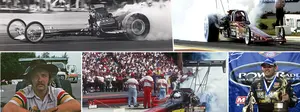

A farewell to friends

It’s been a rough couple of weeks for drag racing fans of the Heroes of Yesteryear, with the passings of Chuck Beal, John Collins, Doug Kruse, and Frank Hall, all names that should be familiar to followers of this column.
Beal had a multi-era and multi-generation presence in the sport, first as an early hero and national event winner in the Alcohol Funny Car ranks and then later as a nitro Funny Car pilot and finally as the mentor to a NetGen nitro racer in his grandson, Brandon Welch. Collins was a strong national event campaigner in Funny Car over two decades; Kruse was a seminal figure in the 1970s as an organizer of the Professional Dragster Association; and Hall as a former Funny Car world champ and NHRA Division Director.
![]()
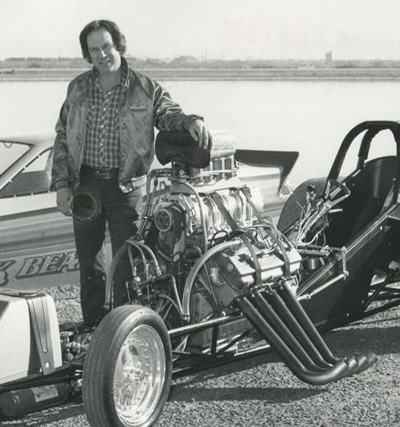 Beal, who died July 13 of complications from a heart procedure at age 74, will forever hold a special place in my memory as he was among the first to welcome a neophyte drag racing reporter to the business. I joined the National Dragster staff just before the summer of 1982, and didn’t get to “work” a national event until that year’s World Finals, so I served my apprenticeship covering match races at Orange County Int’l Raceway, home every month to at least one major nitro/alcohol flopper bash.
Beal, who died July 13 of complications from a heart procedure at age 74, will forever hold a special place in my memory as he was among the first to welcome a neophyte drag racing reporter to the business. I joined the National Dragster staff just before the summer of 1982, and didn’t get to “work” a national event until that year’s World Finals, so I served my apprenticeship covering match races at Orange County Int’l Raceway, home every month to at least one major nitro/alcohol flopper bash.
I was still way too green (and, who am I kidding, intimated as well) to approach Don Prudhomme for an interview, but Chuck and his team welcomed me with open arms, gave me the inside scoop on everything was that happening, especially in his regular battles with Brad Anderson for West Coast supremacy. There were others -– guys like Hans Kuesel, Jim DePasse, and Lou Gasparrelli –- who gave the young kid much more than the time of day and allowed me to gain a solid footing. It’s no small wonder that Alcohol Funny Car was my favorite class to cover back then.
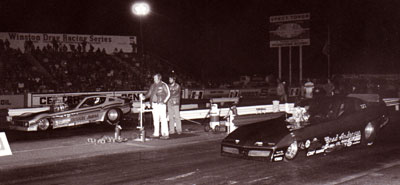 Beal – who held the ultra-cool 9-to-5 job title of “nuclear quality engineer” -- began his racing career in dragsters in 1966, running both gas- and alcohol-burning dragsters until the late 1970s, when he switched to Alcohol Funny Car. He won back-to-back Winternationals titles in 1982 and ’83, scored multiple event wins in divisional competition, and was a popular and successful match racer.
Beal – who held the ultra-cool 9-to-5 job title of “nuclear quality engineer” -- began his racing career in dragsters in 1966, running both gas- and alcohol-burning dragsters until the late 1970s, when he switched to Alcohol Funny Car. He won back-to-back Winternationals titles in 1982 and ’83, scored multiple event wins in divisional competition, and was a popular and successful match racer.
After a high-speed rollover crash at the 1991 Winternationals destroyed his Alcohol Funny Car, Beal made the jump to the nitro ranks in 1994 and qualified consistently during a number of limited campaigns.
In 2012, Beal began helping his grandson, Welch, launch his nitro Funny Car career, tutoring him and helping him get his license.
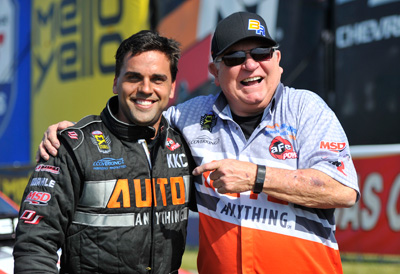 The two made their official debut at the 2015 fall Las Vegas event. I hadn’t seen Beal in more than a decade, and when I stepped into their trailer in Vegas it was like a trip back in time. We were both much older than the first time we met, but the vibe was the same, and he welcomed me again, and I welcomed him back.
The two made their official debut at the 2015 fall Las Vegas event. I hadn’t seen Beal in more than a decade, and when I stepped into their trailer in Vegas it was like a trip back in time. We were both much older than the first time we met, but the vibe was the same, and he welcomed me again, and I welcomed him back.
He fought through a series of heart-related issues the last two years, always eager and ready to get back to the track and to help his grandson fulfill his lifelong dream. When Brandon called me two weeks ago to let me know he’d had a real setback, it was crushing, and that he passed so quickly was another blow. I had hoped to see him at least once more to thank him, but never got the chance, so I’m doing it here. Thanks, Chuck. We’re going to miss you.
![]()
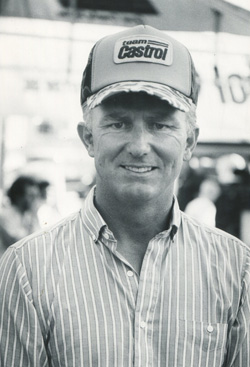 Although Collins retired from driving back in 1985, and I had gotten precious little time to know him, I’d see him occasionally at national events over the last few years and he’d call me every now and then to talk about racing.
Although Collins retired from driving back in 1985, and I had gotten precious little time to know him, I’d see him occasionally at national events over the last few years and he’d call me every now and then to talk about racing.
One of those chats ended up being material for a pretty good column about his Datsun 280ZX Funny Car body, which was the first foreign-car body allowed by NHRA in the class, and helped open the door for today’s fleet of Toyotas. Collins died July 14 after a short battle with cancer. He was 68. We hadn’t spoken in a few months so it also took me by surprise when racer/racetrack operator Keith Haney, for whom Collins had been working recently, called to break the news.
Collins, who first dabbled in dragsters, began racing Funny Cars in 1970, driving the Atlas Tool Special Ford Maverick of John Bateman. The duo campaigned a Mustang the following year, a car that Collins purchased after Bateman retired.
After running his own car for several years, Collins was hired in 1974 as the driver of Tom “the Mongoose" McEwen’s second English Leather Duster Funny Car, which he drove through the 1976 season. Collins brother, Greg, also was part of the team which ran mostly the East Coast tracks while “the Mongoose” plied the West Coast.
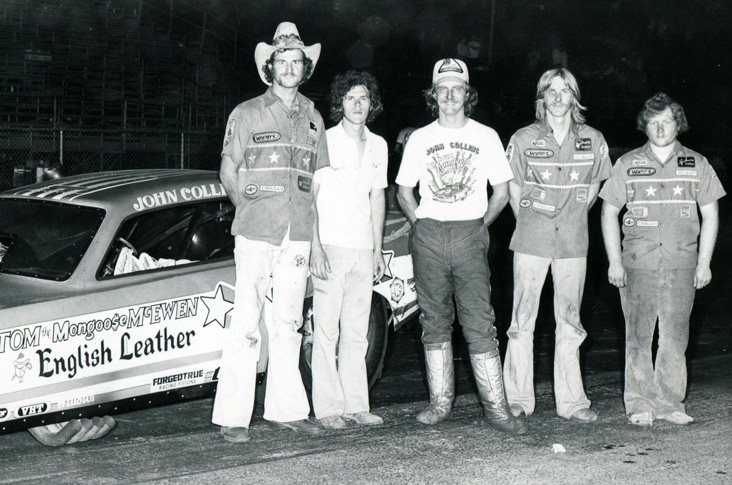
“He was a good guy, a good racer,” McEwen told me earlier this week. “I had gotten to a point where I had so many bookings for the car that I needed a second car, and John was a good fit. I’d known him and his brother from just being at the same races, and I needed someone like him who I could trust with my name, not someone who’s going to get into a barfight or say the wrong thing or do something that would mess up the sponsorship.”
Collins struck out back on his own in 1977 when he signed a sponsorship deal with Pioneer Stereo for a new Duster entry, which was followed a year later by a swoopy Trans Am, then the Z cars, the first of which debuted at the 1980 Winternationals, and before long other drivers, including Gary Densham, Chuck Etchells, and Tm Grose, were using the body.
{"preview_thumbnail":"/sites/default/files/styles/video_embed_wysiwyg_preview/public/video_thumbnails/avZKrv9SFSA.jpg?itok=DEc320Ua","video_url":"https://youtu.be/avZKrv9SFSA","settings":{"responsive":1,"width":"854","height":"480","autoplay":0},"settings_summary":["Embedded Video (Responsive)."]}
After the Pioneer deal ended in 1982, Collins sat out the 1983 season and then returned in 1984 with backing from a different stereo company, JVC Car Audio. It was in the JVC Audio Express Camaro that Collins scored his lone national event victory at the Phoenix event at the end of the 1985 season, beating John Force in the final round, and also in that car that he was part of a savage two-car wreck with Ed McCulloch at the Cajun Nationals, where “the Ace” lost the handle on his Miller Lite Olds and collected Collins. Both cars slid through lights on their roofs, but neither driver was injured.
As they were led away by medical personnel, Collins wrapped an arm around McCulloch, and was surprisingly chipper when interviewed by Steve Evans afterwards.
Collins retired a few years later, in part due to a divorce, but remained a regular visitor to national events. Every time I saw him he had a smile on his face, and I know that he’d have gotten back into the saddle had anyone offered him a ride.
![]()
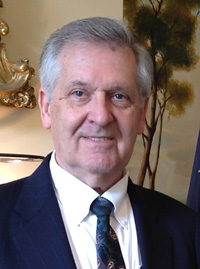 Most fans know Kruse’s fame from one of two ways –- either as the promoter of the monster PDA Top Fuel races of the ;60s and ‘70s or as an innovative fabricator. My former colleague, John Jodauga, was kind enough to supply me with this great pocket bio on the man, who died on June 19 at the age of 81
Most fans know Kruse’s fame from one of two ways –- either as the promoter of the monster PDA Top Fuel races of the ;60s and ‘70s or as an innovative fabricator. My former colleague, John Jodauga, was kind enough to supply me with this great pocket bio on the man, who died on June 19 at the age of 81
Kruse, a California Hot Rod Reunion Honoree, was a renowned racing promotor, aluminum fabricator, and a major talent in many other fields. Kruse was a highly educated individual who had worked on major projects in the automotive, aviation, aerospace, computer, marketing and military industries along with many other technology-related fields. But Kruse will be best remembered for his pioneering role in establishing the Professional Drag Racing Association, which he had operated as both president and race director. The first PDA race, which was held at Lions Drag Strip in 1967, attracted a total of 94 Top Fuelers which showed up to compete in the mammoth 64-car field, with respectively large contingents of cars for the Top Gas and Jr. Fuel programs.
Kruse first became involved in hot rodding by racing a ’39 Ford two-door sedan while studying engineering at the University of Maryland. He moved to Southern California in 1960 and learned how to form aluminum while working on Robert “Jocko” Johnson’s famed streamlined Top Fueler. This led to the establishment of his own fabrication shop, where he worked on everything from race cars to motor coach grilles and mail handling systems. He later began design and construction work for Reno Air Race planes such as the Red Baron and Tsunami. This led to his introduction to engineers from Lockheed’s famous Skunk Works program, from whom he learned a great deal about aerodynamics and streamlining.
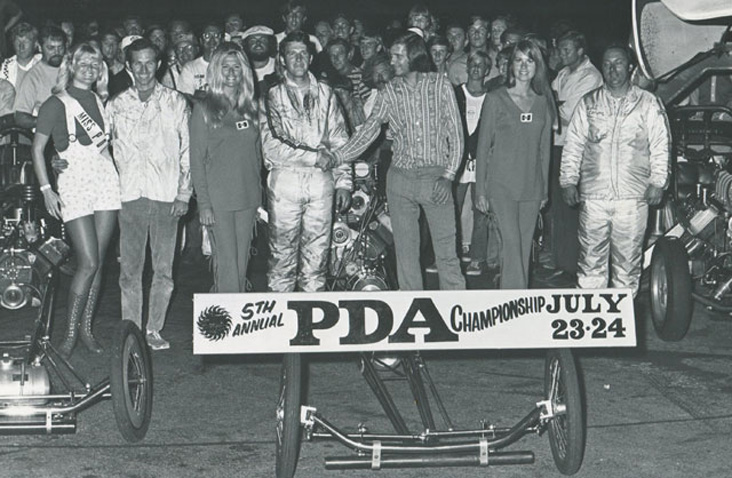
During this time, Kruse continued his education with studies at UCLA in business management, and he became an active member of the Society of Automotive Engineers, serving on the group’s national board of directors.
Kruse’s pursuit of higher education never stopped as he earned a bachelor of science degree from the University of Maryland as the oldest graduate of the class of 2013. He received his CHRR honors in 2015, and at the time of his passing he was nearing the completion of an aerodynamically advanced V-8 diesel-powered streamliner of his own design with which he had intended to break the long-standing mark of 350.092 that had been set in 2006.
![]()
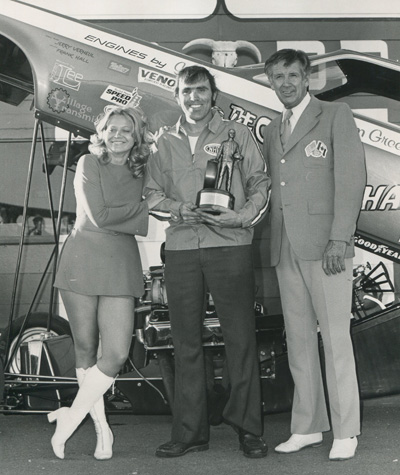 Last but certainly not least was Hall, a well-known and greatly-liked fixture in the Northwest for decades. Most probably either know him as the driver of Jerry Ruth’s Funny Cars, or for his two-year stint as Division 6 Director, or as the surprising Funny Car champion of 1973, when he drove Jim and Betty Green’s Green Elephant to the title.
Last but certainly not least was Hall, a well-known and greatly-liked fixture in the Northwest for decades. Most probably either know him as the driver of Jerry Ruth’s Funny Cars, or for his two-year stint as Division 6 Director, or as the surprising Funny Car champion of 1973, when he drove Jim and Betty Green’s Green Elephant to the title.
Hall, who died July 16, began racing in the late 1950s, driving supercharged gas dragsters with Wayne Caldwell and then injected fuel dragsters through the late 1960s, including one in partnership with Jerry Verhuel, who would remain a part of his career until the end.
In 1970, Hall began competing in Funny Car, driving for his longtime friend, “the King of the Northwest,” Jerry Ruth, for which Verhuel was the tuner, and a number of other cars, including Wayne Franklin’s Spider Dodge Demon, Mike Cyr’s Skipper’s Fish and Chips Mustang, Bill Spevacek’s Duster, and, for a short time, “Jungle Jim” Liberman’s second car, which J.J. had left in the Northwest one year.
I talked to Ruth earlier this week, and he was effusive in his praise for Hall’s skills behind the wheel.
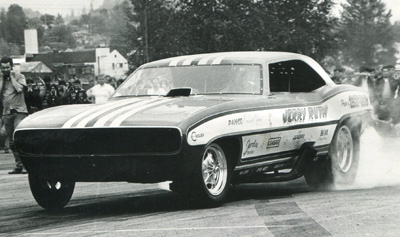 “He was the best bolt-in driver I’d ever seen,” he said. “You could bolt him into any car and he’d do a good job. You could tell him to drive it to 1,000 feet and you could measure it that he went to that distance. He was really, really good.”
“He was the best bolt-in driver I’d ever seen,” he said. “You could bolt him into any car and he’d do a good job. You could tell him to drive it to 1,000 feet and you could measure it that he went to that distance. He was really, really good.”
Despite that prowess, Ruth said he has some very serious misgivings the first time he watched Hall drive his Camaro, during licensing at Seattle Int’l Raceway.
“I was standing downtrack, about 500-600 feet when he did his burnout, and he just kept coming and smoking the tires,” Ruth recalls. “He goes right by me still smoking the tires and disappeared into the darkness. I was like, ‘What was that?’ When I got down there I found out that the [throttle linkage] that went through the bellhousing and bent over and he couldn’t pull it back. He pulled the fuel shutoff and got it stopped."
 In 1972, Hall teamed up with Jim and Betty Green to drive their Green Elephant Vega after their original driver, Ray Hadford, was injured, and won the world championship with a holeshot victory over Bobby Rowe at the NHRA World Finals in Amarillo, Texas, and was runner-up at the following year’s Winternationals, then returned to drive for Ruth later that season. (You can read more about Hall’s tenure with the Green Elephant in this column I wrote a few years ago.)
In 1972, Hall teamed up with Jim and Betty Green to drive their Green Elephant Vega after their original driver, Ray Hadford, was injured, and won the world championship with a holeshot victory over Bobby Rowe at the NHRA World Finals in Amarillo, Texas, and was runner-up at the following year’s Winternationals, then returned to drive for Ruth later that season. (You can read more about Hall’s tenure with the Green Elephant in this column I wrote a few years ago.)
Green was heavily involved in the safety equipment business for decades as Operations Manager for Competition Specialties (a longtime sponsor of Ruth’s car),
In March of 1977, Hall was named NHRA’s Northwest Division Director, replacing Jack Shannon. He remained in that post until Nov. 1979, and then returned to Funny Car competition, driving for Ron Hodgson through for two seasons in the Flo-Rite (1980) and Yukon Gold (1981) Trans Ams that were tuned by Verhuel.
Ruth says he last saw Hall a few weeks ago, at a memorial Cacklefest for “Gentleman Hank” Johnson, who also passed recently. Despite his ill health and discomfort, Hall was in Johnson’s tribute car for his last ride, so there’s something full-circle to be said about that and his desire to pay tribute to a fallen colleague and friend.
“He was just a great guy,” added Ruth, “He was articulate, intelligent, and well-groomed. He had it all. He was a good friend of mine for a long time, and I’ll miss him.”
Four good guys, all with solid ties to the history of our sport, gone too soon. They won’t be forgotten.
Phil Burgess can be reached at pburgess@nhra.com



















































